November 2004
advertisement
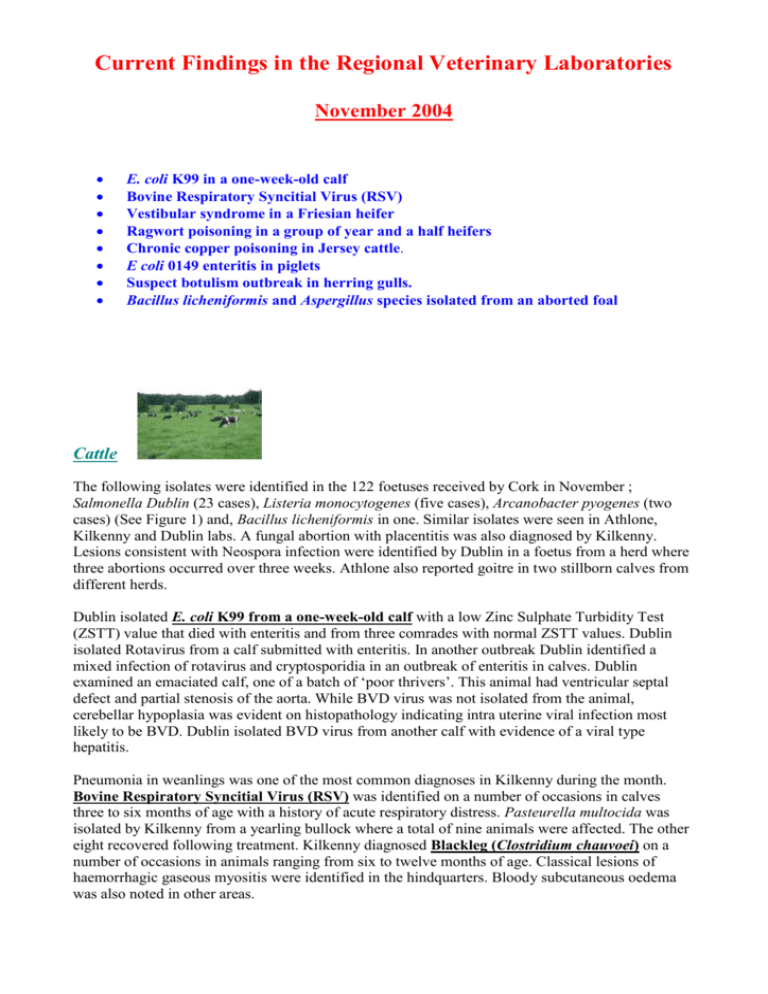
Current Findings in the Regional Veterinary Laboratories November 2004 E. coli K99 in a one-week-old calf Bovine Respiratory Syncitial Virus (RSV) Vestibular syndrome in a Friesian heifer Ragwort poisoning in a group of year and a half heifers Chronic copper poisoning in Jersey cattle. E coli 0149 enteritis in piglets Suspect botulism outbreak in herring gulls. Bacillus licheniformis and Aspergillus species isolated from an aborted foal Cattle The following isolates were identified in the 122 foetuses received by Cork in November ; Salmonella Dublin (23 cases), Listeria monocytogenes (five cases), Arcanobacter pyogenes (two cases) (See Figure 1) and, Bacillus licheniformis in one. Similar isolates were seen in Athlone, Kilkenny and Dublin labs. A fungal abortion with placentitis was also diagnosed by Kilkenny. Lesions consistent with Neospora infection were identified by Dublin in a foetus from a herd where three abortions occurred over three weeks. Athlone also reported goitre in two stillborn calves from different herds. Dublin isolated E. coli K99 from a one-week-old calf with a low Zinc Sulphate Turbidity Test (ZSTT) value that died with enteritis and from three comrades with normal ZSTT values. Dublin isolated Rotavirus from a calf submitted with enteritis. In another outbreak Dublin identified a mixed infection of rotavirus and cryptosporidia in an outbreak of enteritis in calves. Dublin examined an emaciated calf, one of a batch of ‘poor thrivers’. This animal had ventricular septal defect and partial stenosis of the aorta. While BVD virus was not isolated from the animal, cerebellar hypoplasia was evident on histopathology indicating intra uterine viral infection most likely to be BVD. Dublin isolated BVD virus from another calf with evidence of a viral type hepatitis. Pneumonia in weanlings was one of the most common diagnoses in Kilkenny during the month. Bovine Respiratory Syncitial Virus (RSV) was identified on a number of occasions in calves three to six months of age with a history of acute respiratory distress. Pasteurella multocida was isolated by Kilkenny from a yearling bullock where a total of nine animals were affected. The other eight recovered following treatment. Kilkenny diagnosed Blackleg (Clostridium chauvoei) on a number of occasions in animals ranging from six to twelve months of age. Classical lesions of haemorrhagic gaseous myositis were identified in the hindquarters. Bloody subcutaneous oedema was also noted in other areas. Two suckler calves submitted from the same herd to Cork had similar gross and histopathological lesions. A moderate hepatic jaundice and pale renal cortices on gross observation. On microscopic examination, a diffuse hepatitis and cortical interstitial nephritis along with suppurative infiltration filling the convoluted tubular lumens. These lesions are seen sporadically in suckler calves submitted to the Cork Laboratory and the aetiology is unconfirmed. . Cork diagnosed vestibular syndrome in a Friesian heifer of six months of age. The diagnosis was based on clinical signs, clinical pathology and response to therapy. The heifer had loss of balance, head tilt to the right, ventral deviation of the right eyeball and right facial nerve paralysis. There was a neutrophilia with left shift present on haematological examination. Comprehensive florfenicol treatment was given every second day and complete recovery was effected in three weeks. Athlone reported ragwort poisoning in a group of year and a half heifers. The third animal to die was submitted for post-mortem examination. Clinically it had been showing signs of dullness, lethargy, tenesmus and “dummy like” appearance. Gross and histopathological changes confirmed ragwort poisoning. The remaining animals in the batch were blood sampled and a number showed raised liver enzymes. Dublin isolated Pasteurella multocida from an adult cow with a purulent bronchopneumonia from which lungworm larvae were also identified on histopathology. Multiple nodules spread throughout both lungs of a Friesian cow were identified by Cork as being spindle cell tumours. The origin was probably neoplastic pleural tissue. Hypomagnesaemic tetany was suspected as causing the death of a four-year-old cow submitted to Limerick RVL, with a history of sudden death. No significant lesions were seen on gross postmortem examination. A CSF magnesium concentration of 0.59mmol/litre suggested that grass tetany was the most likely cause. An eleven year old cow showing signs of weight loss, blindness, circling and aggression over a three week period, was reported to the Clare DVO as a BSE suspect. The animal was euthanased and the brain was submitted to the CVRL for histopathology. There was no evidence of BSE in the sections examined, but a tumour described as a glioblastoma multiforme was found, extending from the right side of the thalamus to the mid-brain. This is a primary tumour of the brain (glioma) and is seen most commonly in dogs, but also occasionally in cattle and cats. They can be very difficult to detect grossly but, in this case, it was easily seen when the brain was being sectioned. Limerick RVL investigated the death of three cows in a Jersey dairy herd. Four cows showed signs of anorexia, ataxia and sub-normal rectal temperature. Haemoglobinuria was a feature in one case. Three cows died, two of which were submitted for post-mortem examination. Jaundice was obvious in the cow with the haemoglobinuria. Liver damage was also obvious in the second cow. Blood samples taken prior to death showed raised serum copper values (25.3 and 97.9 μmol/litre. Normal range 9.4-24.0 μmol/litre). Liver copper values were raised significantly in both cows. Histopathological examination of the livers confirmed the diagnosis of chronic copper poisoning. Investigations are ongoing into the possible source of the copper, as there was no history of significant copper supplementation. Copper poisoning is not very common in cattle. There are suggestions that the Jersey breed may be more susceptible than other breeds. Sheep Several store lambs with a history of scour were submitted to Kilkenny. Clostridium sordelli was identified in one case with a haemorrhagic abomasitis and enteritis. However, by far the most common finding was very high worm egg counts with counts of up to 8,000 eggs per gram of faeces. When the fact that the faecal samples in these cases are very dilute is taken into consideration, these figures indicate a very severe worm infestation. Pigs E coli 0149 enteritis (See Figure 2) was diagnosed by Kilkenny in piglets 33 days old that had been weaned for three days. E. coli O149 was isolated from all four piglets submitted. Two thirteenweek-old pigs received in Cork had both pneumonia and ulceration of the pars oesophagea. Pasteurella multocida was isolated from the lungs from both pigs and Salmonella typhimurium DT104b was isolated from one. Fattener pigs were submitted to Athlone for post-mortem examination. An increase in mortality rate was noticed on the farm with pigs showing evidence of anaemia, dullness and death in two to three days. Post-mortem examination showed vegetative endocarditis in 11 of 14 pigs examined from the farm. There was gastric ulceration found in two of the pigs. Culturing from the pigs revealed Erysipelothrix rhusiopathiae from the heart lesions and Salmonella derby from the heart lesion and from the intestine. The aetiology of the condition is still being investigated. A ten-year-old pot-bellied pig was submitted to Cork following muscular weakness, hind leg paresis and in-coordination that progressed to recumbency within a week. Histopathology of the spinal cord showed changes in the grey and white matter at the level of the caudal thorax and lumbar cord. There was evidence of myelin damage on the white matter with focal swelling of the myelin sheaths with macrophages in some of the swellings and loss of axonal definition. There were small haemorrhages in the grey matter considered due to terminal hypoxia. The cord damage suggested pressure changes had occurred. Birds Dublin are investigating a suspect botulism outbreak in herring gulls. The outbreak has occurred adjacent to a landfill site and the distribution of deaths/ carcass findings are classical for seaside botulism where carcasses have been found beside the landfill and on the high tide mark on beaches. Winter botulism although uncommon is not unusual near landfill sites as toxin can survive in microenvironments within the tip and becomes a problem when it is exposed and birds have access. Dublin are investigation deaths of wild pigeons, all become ‘drowsy’ and ‘drop off’ their perch on trees. Initial findings indicate a viral origin. Birds had a very acute viral type hepatitis, which is visible grossly as a pronounced hepatomegaly, ulceration is also evident in the gizzard, the only location where intranuclear inclusion bodies are evident. Periorbital sinusitis in a small turkey flock, which has 90% morbidity and 25% mortality, is being investigated for suspected mycoplasma infection. Kilkenny diagnosed sinusitis in a turkey. E. coli was the only isolate. Dublin diagnosed Marek’s disease in a rooster. Other Species Cork isolated Bacillus licheniformis and Aspergillus species from an aborted foal. Both isolates are associated with contaminated forage. Streptococcus equi subspecies equi was isolated from a swab taken from a discharging submandibular gland of a foal and submitted to Limerick RVL. Kilkenny diagnosed pancreatic hypoplasia in a four-month-old greyhound. It had a history of weight loss and inappetance. High glucose levels had been detected by the veterinary practitioner. CAPTIONS FOR PHOTOGRAPHS “Fibrin sheet on the liver of A. pyogenes bovine abortion – photo Donal Toolan” “E coli 0149 enteritis in a piglet 33 days old – photo Donal Toolan”
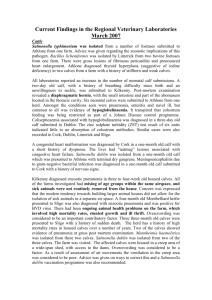
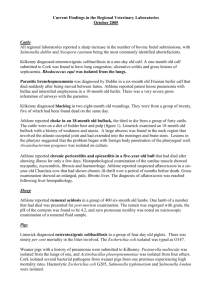
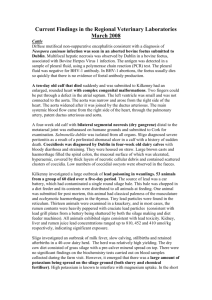
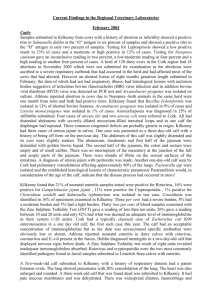

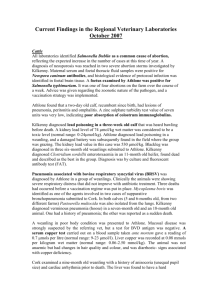

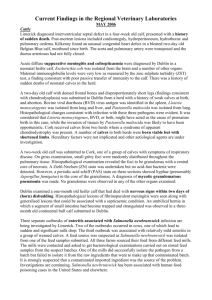
![South east presentation resources [pdf, 7.8MB]](http://s2.studylib.net/store/data/005225551_1-572ef1fc8a3b867845768d2e9683ea31-300x300.png)